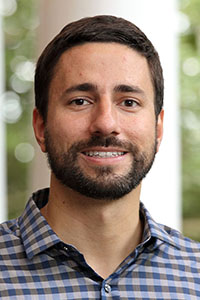Date/Time
Date(s) - 02/01/2021
9:35 am - 10:30 am
Categories
Steven R. Caliari, Ph.D.
Assistant Professor
Chemical Engineering
University of Virginia
Title: Designing biomaterials to understand mechanical regulation of fibrosis and tissue regeneration
Abstract: Hydrogels have proven useful in a range of human health applications because of their ability to mimic salient tissue properties including high water content, controlled ligand presentation, and soft tissue mechanics. Recent advances in hydrogel design are increasingly moving away from static, monolithic platforms and toward dynamic, interactive, and responsive materials that capture the complexity of native cellular microenvironments in wound healing and tissue regeneration. My group engineers instructive biomaterials to tackle human health challenges include treatment of fibrotic disease and repair of injured tissues. In this talk I will discuss our progress on designing hydrogels as disease models that recapitulate the dynamic mechanical properties of fibrosis as well as using hydrogels mimicking the mechanical environment of developmental niches to repair volumetric muscle loss injuries.
Biography: Steven joined the faculty of the University of Virginia in 2016 as an Assistant Professor in the Department of Chemical Engineering with a secondary appointment in the Department of Biomedical Engineering. Prior to joining UVA he was an NIH Postdoctoral Fellow in the Department of Bioengineering at the University of Pennsylvania. Steven completed his B.S. in Chemical Engineering at the University of Florida and received both his M.S. and Ph.D. in Chemical Engineering from the University of Illinois at Urbana-Champaign. His lab designs biomaterials to explore the dynamic interplay between cells and their microenvironment, applying these platforms to address fundamental human health challenges in understanding disease and engineering tissues. Steven recently received the NIH (NIGMS) Maximizing Investigators’ Research Award (MIRA) andhis lab is grateful for generous support from the NIH, DoD, NSF, V Foundation, and UVA-Coulter Translational Research Partnership.

